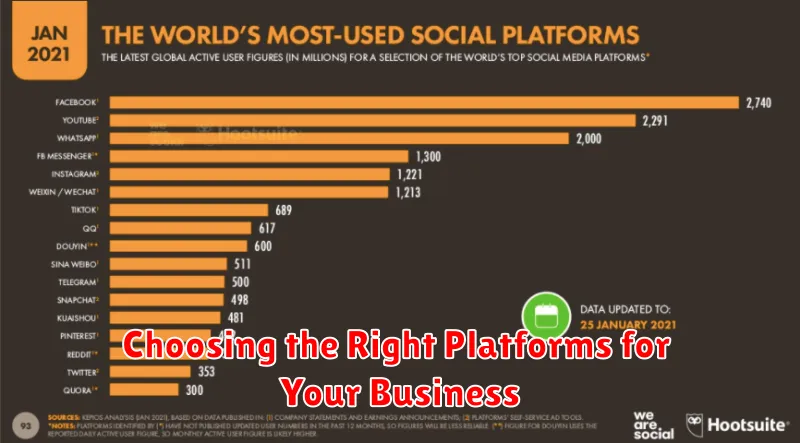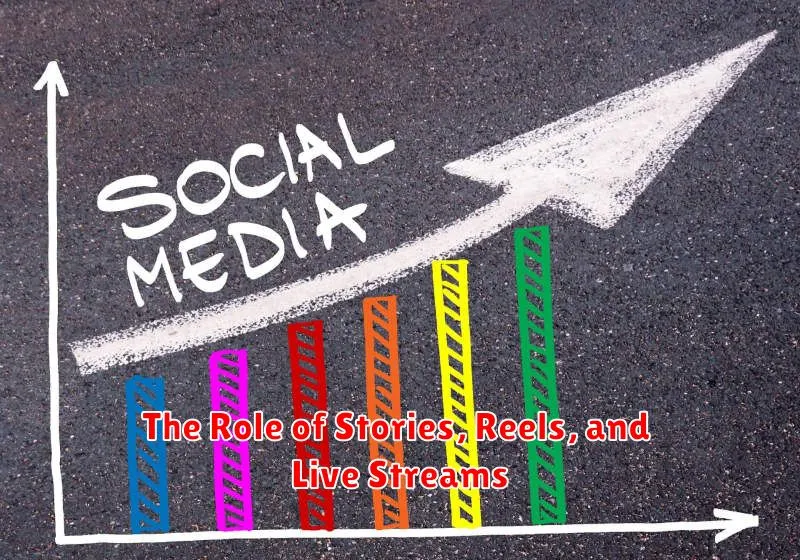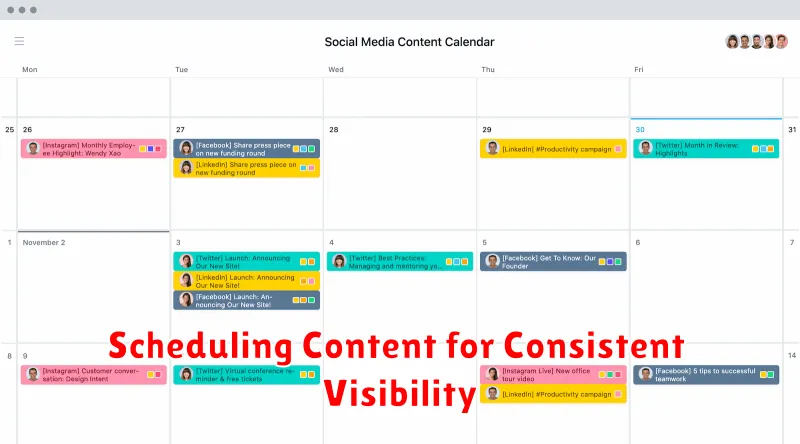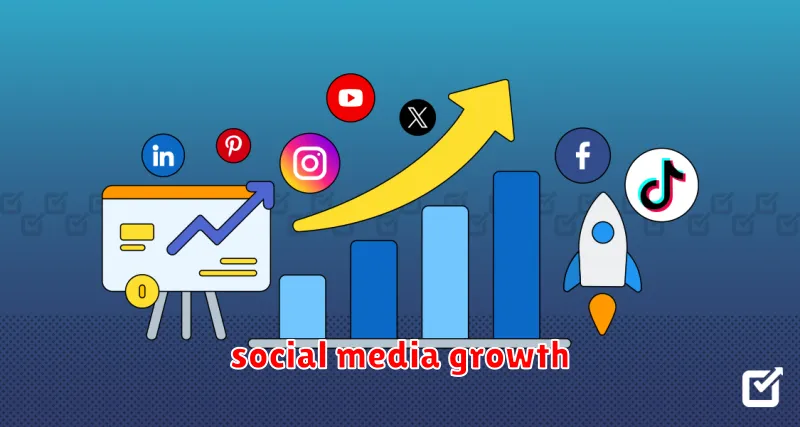Are you struggling to leverage social media for driving traffic and boosting sales? This article outlines proven social media tactics to significantly increase your website traffic and ultimately, your sales. Discover effective strategies for optimizing your social media presence, engaging your audience, and converting followers into paying customers. Learn how to harness the power of platforms like Facebook, Instagram, Twitter, and more to achieve your marketing goals and unlock substantial business growth. We’ll explore content marketing best practices, paid advertising strategies, and analytics techniques to help you measure your success and refine your social media approach for maximum impact.
Choosing the Right Platforms for Your Business

Selecting the right social media platforms is crucial for effective marketing. Don’t spread yourself too thin; focus on platforms where your target audience is most active.
Consider your business goals. Are you aiming for brand awareness, lead generation, or direct sales? Different platforms excel in different areas. For example, Instagram is visually driven and ideal for showcasing products, while LinkedIn is better for professional networking and B2B lead generation.
Analyze your competitors’ strategies. See which platforms they’re using successfully and why. This can provide valuable insights into effective approaches for your own business.
Start small and focus on mastering a few key platforms before expanding. Consistent, high-quality content is more valuable than a scattered presence across numerous platforms.
Regularly evaluate your performance on each platform. Track key metrics such as engagement, reach, and conversions to determine what’s working and what needs adjustment. This data-driven approach allows you to optimize your strategy and maximize your return on investment.
Creating Shareable Content That Drives Engagement
Creating shareable content is crucial for driving traffic and sales on social media. High-quality visuals are essential; captivating images and videos significantly increase engagement. Compelling storytelling is another key element; humanizing your brand and connecting with your audience on an emotional level encourages sharing.
Concise and impactful messaging is vital. Keep your content brief and to the point, focusing on the core value proposition. Clear calls to action (CTAs) are also necessary; explicitly tell your audience what you want them to do (e.g., visit your website, make a purchase). Using strong verbs in your CTAs improves their effectiveness.
Utilizing relevant hashtags helps increase visibility and reach a wider audience. Interactive content, such as polls, quizzes, and Q&A sessions, boosts engagement significantly. Finally, monitoring and analyzing performance is crucial; track metrics such as shares, likes, and comments to understand what resonates best with your audience and optimize your content strategy accordingly.
The Role of Stories, Reels, and Live Streams

Stories, Reels, and live streams are crucial for driving traffic and sales on social media. They offer a dynamic and engaging way to connect with your audience beyond static posts.
Stories, with their ephemeral nature, create a sense of urgency and encourage immediate engagement. Their diverse features, such as polls and quizzes, foster interaction and gather valuable data about your audience’s preferences.
Reels, short-form video content, leverage the popularity of visual storytelling. They are highly shareable and can quickly go viral, significantly expanding your reach. Compelling visuals and concise messaging are key to successful Reels.
Live streams provide a real-time connection with your audience, fostering a sense of community and building trust. They are ideal for Q&A sessions, product demonstrations, and behind-the-scenes glimpses, thus strengthening brand loyalty and driving sales.
By strategically utilizing these three features –Stories, Reels, and live streams – businesses can effectively increase brand awareness, generate leads, and boost conversions, ultimately driving substantial traffic and sales.
How to Use Hashtags to Expand Reach
Hashtags are crucial for expanding your social media reach. They categorize your content, making it discoverable by users searching for specific topics. Effective hashtag use involves a strategic mix of broad and niche hashtags.
Research relevant hashtags: Analyze your competitors and industry leaders to identify popular and relevant hashtags. Use hashtag research tools to find trending and niche options.
Use a variety of hashtags: Employ a mix of broad, highly popular hashtags (e.g., #marketing) and more specific, niche hashtags (e.g., #contentmarketing). This balances broad exposure with targeted reach to a specific audience.
Don’t overuse hashtags: While using multiple hashtags is beneficial, avoid overwhelming your posts. Too many hashtags can look spammy and detract from the message. Experiment to find the optimal number for your platform and audience.
Track hashtag performance: Monitor which hashtags generate the most engagement. Analyze this data to refine your hashtag strategy and optimize future posts for improved reach and conversions.
Stay updated on trends: Hashtag trends are dynamic. Regularly monitor trending hashtags to incorporate relevant ones into your content for maximum visibility and engagement.
By implementing these strategies, you can effectively leverage hashtags to increase your social media visibility, attract a wider audience, and ultimately drive traffic and sales.
Scheduling Content for Consistent Visibility

Maintaining a consistent online presence is crucial for driving traffic and sales. Scheduling your social media content is a key strategy to achieve this. It ensures regular updates, preventing periods of inactivity that can lead to lost engagement.
Utilizing scheduling tools allows you to plan posts in advance, optimizing your content for peak engagement times. This consistent visibility helps to build brand awareness and cultivates a loyal following. It also allows for a more efficient workflow, saving you time and resources in the long run.
A well-structured content calendar, incorporating diverse content formats like images, videos, and stories, can maintain audience interest. By scheduling content strategically, you improve the chances of your posts being seen by your target audience, leading to increased website traffic and ultimately, higher sales.
Consider using social media analytics to identify optimal posting times and analyze the performance of previously scheduled content. This data-driven approach will help you refine your scheduling strategy for even greater impact.
Collaborating with Influencers and Creators
Collaborating with influencers and creators is a powerful social media tactic to drive traffic and sales. Partnering with individuals who already have a dedicated and engaged following allows you to tap into their audience, expanding your brand’s reach organically.
Careful selection is key. Choose influencers whose audience aligns with your target market and whose values resonate with your brand. Micro-influencers, with smaller but highly engaged followings, can often be more effective than macro-influencers, offering higher engagement rates and a more authentic connection.
Clearly defined goals and metrics are essential for a successful collaboration. Establish specific objectives, such as increased website traffic or sales conversions, and track key performance indicators (KPIs) to measure the campaign’s success. This data informs future influencer marketing strategies.
Transparent communication is crucial throughout the process. Provide influencers with clear briefs, outlining campaign expectations and brand guidelines. Maintain open communication to ensure alignment and address any challenges promptly. Review and analyze the results together to optimize future collaborations.
Beyond simple sponsored posts, consider more creative and engaging content formats such as live streams, Instagram takeovers, or product reviews. This fosters authentic engagement and builds stronger relationships with the influencer’s audience.
By strategically collaborating with influencers and creators, businesses can leverage the power of social proof, build brand trust, and ultimately drive significant traffic and sales growth.
Running Social Media Ads Effectively
Running effective social media ads requires a strategic approach. Begin by clearly defining your target audience. Understanding their demographics, interests, and online behavior is crucial for effective ad targeting.
Next, craft compelling ad creatives. Use high-quality visuals and concise, persuasive copy that highlights the unique selling proposition (USP) of your product or service. A/B testing different ad variations is essential to optimize performance.
Budget allocation is key. Start with a reasonable budget and gradually increase it based on performance data. Track your return on ad spend (ROAS) closely to ensure you’re getting a good return on your investment.
Campaign optimization is an ongoing process. Regularly analyze your ad performance metrics, such as click-through rates (CTR) and conversion rates. Adjust your targeting, creatives, and bidding strategies based on these insights to maximize your results. Utilize the platform’s built-in analytics tools to track progress and identify areas for improvement.
Finally, consider using retargeting strategies to re-engage users who have previously interacted with your ads or website. This can significantly improve conversion rates.
Tracking Social Media Performance and ROI
Measuring the success of your social media efforts requires a robust tracking system. Key Performance Indicators (KPIs) should be aligned with your overall business goals. For driving traffic, monitor website clicks from social media posts and the number of new followers. For sales, track conversions directly attributed to social media campaigns (e.g., purchases made after clicking a social media ad).
Utilize built-in analytics provided by each social media platform. These tools offer valuable insights into engagement metrics (likes, shares, comments), reach (how many people saw your content), and audience demographics. Supplement platform analytics with UTM parameters in your social media links to precisely track traffic sources and campaign effectiveness within your website analytics.
To calculate Return on Investment (ROI), compare the cost of your social media activities (advertising spend, content creation, staff time) to the revenue generated as a direct result. This can be challenging to attribute precisely, but focusing on easily quantifiable actions (like conversions from social media ads) provides a clearer picture of your social media’s financial impact.
Regularly analyze your data and adjust your strategy accordingly. This iterative process allows you to optimize campaigns, allocate resources effectively, and maximize your return on investment from social media.

